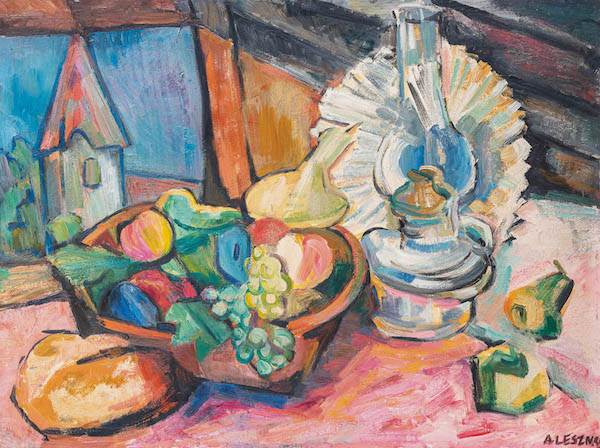Biography
Anna Lesznai was born as Amália Moscovitz, and later took her surname after the name of a village - Leszna - close to the family estate in Körtvélyes. She used the name Anna only as a stage name. In 1872 the family bought the Körtvélyes estate, where they spent the spring and summer months.
As a child (in Körtvélyes) she learned embroidery from peasant women, and then studied applied arts in Budapest and Paris. Her early poems were published in Nyugat through his cousin Lajos Hatvany. Her first volume was praised by Endre Ady, and she designed the covers of several first editions of Ady's books. In addition to Ady, Margit Kaffka, Béla Balázs and György Lukács were among Anna Lesznai's circle of friends. She had three marriages. At 17 she married Károly Garay, from whom she divorced after the birth of their first child. Lesznai was married to Oszkár Jászi between 1913 and 1918, and they had two children, György and András. From 1919 she lived in Vienna where she met her third husband, Tibor Gergely, a graphic artist and painter.
The "full life" she always wanted was only fully found in the past, in the fairy world of childhood. The safety of her parents' home and the idyllic peace of the garden of Körtvélyes once prevented her from having to face the harsher aspects of reality. Her youth was spent in a strange dream world, and she always remembered this world with strong nostalgia. She sought the elemental harmony of the world in the past and believed that she could only regain this lost harmony by identifying with the universe. The ecstasy of love or the mystical blending with the things of nature was the means of this identification, which dissolved the personality.
Her embroideries, illustrations and literary works are in the style of Hungarian Art Nouveau. The chalice, the vase or the flower holder are the dominant motifs in Lesznai's early embroidery designs. They are the connectors of the composition, linking the elements (flowers, fruits, stylised forms, animal names).
In 1911, as an external member of the Group of Eight, she exhibited textiles with folkloric ornamentation at the group's exhibition. She was involved in the Soviet Republic's plans for art education and was forced to flee, settling in Vienna, from where she returned only in 1930. In her art, the early floral ornamentation was replaced by rural life scenes, oriental motifs and watercolours from the 1920s. According to Lesznai's diary, her period of narrative village life paintings lasted until 1927. In 1932 she participated in a group exhibition at the Ernst Museum. Róbert Berény, published in the same year, regards Anna Lesznai as the visual storyteller of the village, who chose the simplest forms for primary human actions, experiences and emotions. At the KUT (New Society of Artists) exhibitions in 1934 and 1937, she also exhibited works on this theme. In 1938, in a statement written for the catalogue of the Ernst Museum exhibition, she spoke of the deep spiritual roots of his work.
It was in the 1930s that Lesznai first became involved in practical pedagogical work. She taught industrial design at Dezső Orbán's Atelier school and design studio. In 1939, she and her third husband, Tibor Gergely, boarded a ship and settled in the United States, living in New York until her death. Although she visited Hungary in 1965 and 1966, she never returned to Körtvélyes. The occasion for their trip to America was an invitation to give a series of lectures: in the summer of 1939, Lesznai gave an art course and public lectures on Hungarian art in Sandusky, Ohio. Her excellent pedagogical skills are demonstrated by the fact that she was invited to give lectures and seminars in succession, teaching at Wellesley College, Cambridge, near Boston, from 1939 to 1942, at Teachers College, Newark, in 1942, and in 1948, lecturing to primary and secondary school teachers on the art and practice of design at the Lawrence Street School art workshop in New York.
Lesznai considered the story to be the most important means of expressing her view of the world. In addition to her well-known works, her legacy includes nearly one and a half hundred fairy tales, story sketches, thousands of drawings and sketches. While her contemporaries debated whether her was more significant as a poet or as a visual artist, posterity knew her primarily as a fairy tale writer and illustrator, thanks to her work The Journey of the Little Butterfly through Leszna and Neighbouring Fairyland, published in 1978, and the Lesznai Picture Book, published in 1981.

